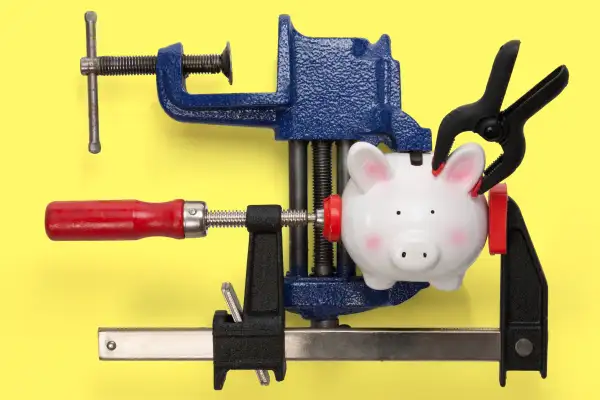7 Ways to Trick Yourself into Saving More Money in 2015

If your New Year's resolutions included growing—or starting—your savings, you're already ahead of the pack.
Only about a third of Americans recently surveyed by Fidelity made any kind of financial resolution this year; and of those who did, just over half were aiming to stash more cash.
Kudos to you for taking this important step toward financial security.
Want to make sure your good intentions aren't derailed before the month is out? The key is taking initial actions that will make repeating good habits easier, says University of Chicago economist Richard Thaler.
"We tend to revert to our long-run tendencies," says Thaler. "To effect real changes, you have to make some structural change in the environment."
With that wisdom in mind, the seven life changes that follow will help you save more money this year.
1. Use Inertia to Your Advantage
Research by Thaler and others has shown that people are victims of inertia: If you aren't used to saving money with regularity, it's likely going to feel like such a chore to start that you'll never bother—or, you'll quit after one account transfer.
But when your money is already being saved automatically, inertia works in your favor, since it'll take more effort to stop saving than to do nothing. That is why a growing number of 401(k) plans offer automatic enrollment with a default monthly contribution rate.
Still, you may need to stick a hand in the machine if you want to have financial freedom in retirement, since the default rate (often around 3% of salary) won't get you far in your golden years. Most planners recommend saving at least 10% of income.
Even if you set up your own plan, you probably haven't touched your contribution rate since; more than a third of participants haven't, according to a TIAA-CREF survey.
You can benefit from another relatively new feature called "auto-escalation." Offered by nearly half of companies, auto-escalation lets you set your savings rate to bump up annually at a date of your choosing and to an amount of your choosing.
For other savings accounts, harness your own "good" inertia by setting up automatic transfers on payday from checking to savings (if you don't see the money, you won't get attached to it). Better yet, ask your HR department if you can split your direct deposit to multiple accounts.
2. Keep Your Eye on One Prize
Setting up automatic savings works well if your income and expenses are predictable; but what if either or both aren't set in stone? You can save money as you go, but you'll be more successful if you narrow your objectives.
Research from the University of Toronto found that savers often feel overwhelmed by the number of goals they need to put away money for—a stress that can lead to failure. Thinking about multiple objectives forces people to consider tradeoffs, leaving them waffling over choices instead of taking action.
One solution? Prioritize your goals, then knock out one at a time. If you know you need to contribute $5,000 to your retirement funds this year, focus on completing that first. Once it's done, move on to saving for that dream home.
Another strategy is to think about your goals as interconnected; participants in the Toronto study were also able to overcome their uncertainty about saving when they integrated their objectives into an umbrella goal. So, for example, if you are saving for both a car and a vacation, consider setting up a "road trip" fund.
3. Focus on the Future
A part of what keeps people from saving is that we don't connect our future aspirations with our present selves, research shows.
One way to get around that is by running some numbers on your retirement using a calculator like T. Rowe Price's. When participants in a study by the National Bureau of Economic Research were sent exact figures showing how retirement savings contributions translated into income in retirement, they increased their annual contributions by more than $1,000 on average.
Another easy trick? Download an app like AgingBooth, which will show you how you'll look as a geezer. One study showed that interacting with a virtual reality image of yourself in old age can make you better at saving.
This trick can work for more than just retirement. Another study found that when savers were sent visual reminders of their savings goals, they ended up with more cash stored up. Consider leaving photos of your goal (e.g., images of your children or dream home) next to the computer where you do your online banking to cue you to put more away.
4. Ignore Raises and Bonuses
As Harvard professor Sendhil Mullainathan has said, the biggest problem with getting a bonus is it'll likely make you want to celebrate and spend it all—plus some.
The windfall creates an "abundance shock," which gives you a misleading sense of freedom.
The simplest solution to this problem is to pretend you never got the raise or bonus in the first place, and to instead direct that new money into savings right away. (Remember the 401(k) auto-escalation tip? Set your contribution to bump up the week you get your raise.)
The same goes for when you return an item to a store for a refund or get a transportation reimbursement check in the mail. The faster you put extra cash into savings, the faster you'll forget about spending it.
5. Make it Contractual
Carrots and sticks work.
One study asked smokers who were trying to quit to save money in an account for six months; at the end of the period, if a urine test showed them free of nicotine, the money was theirs. If not, the cash was donated to charity.
Surprise, surprise: People who participated in the savings account were more likely to have been cigarette-free at the six-month mark than a control group.
If you're the type who responds to disincentives, enlist a buddy who can help you enforce upon yourself some kind of punishment if you don't live up to your savings goal (e.g., you might promise a roommate that you'll clean the bathroom for six weeks).
Maybe you respond better to positive feedback? Simply having a supportive friend or relative to report to on a set schedule may help you achieve results, as many of those who have participated in a group weight loss program like Weight Watchers can attest. Or you might look for some (non-monetary) way to reward yourself if successful.
You can use the website Stickk.com—inspired by the aforementioned study on smokers—to set up a commitment contract that involves incentives or disincentives.
6. Keep Impulses from Undoing Your Budget
Setting aside cash is only half of the equation when it comes to saving more: It's just as important to keep spending under control.
Most people know to shop carefully—and early—for big-ticket items like cars or airline tickets (which are cheapest 49 days before you're due to fly). But the premium for procrastinating on smaller items can also add up: Studies show that people spend more on last-minute purchases partly because shopping becomes a defensive act, focused on avoiding disappointment vs. getting the best value.
So give yourself plenty of time to research any item you're planning to buy. And always go shopping with a list.
When you see an item that tempts you to diverge from your list, give yourself a 24-hour cooling-off period. Ask a sales clerk to keep the item on hold. Or, put it in your online shopping cart, until the same time tomorrow (chances are, that e-tailer will send you a coupon).
Or you could try this trick that Money writer Brad Tuttle uses to determine whether an item is worthy of his dough: Pick a type of purchase you love—in his case, burritos—and use that as a unit of measurement. For example, if you see a $120 shirt you like, you can ask yourself, "Is this really worth 10 burritos?" Likewise, you could measure the cost of an item in terms of how many hours of work you had to put in to earn the money to pay for it.
Also, since gift-shopping procrastination undoes a lot of people's budgets, you might think about starting a spreadsheet where you can jot down ideas for presents year-round. That way, someone's birthday rolls around, you can shop for a specific item on price rather than spending out of desperation.
Finally, remember that "anchor" prices can bias us to be thrifty or extravagant. So when you are shopping for products that range widely in price (like clothes or cars), start by inspecting cheaper items before viewing pricier ones. That way your brain will stay "anchored" to lower prices, and view the costlier options with more scrutiny.
7. Force Yourself to Feel Guilty
Surveys show that about a third of people don't check their credit card statements every month.
That's a problem, and not only because vigilance is your best defense against extraneous charges or credit card fraud. Seeing your purchases enumerated can also help reign in spending by making you feel guilty—one of many reasons people avoid looking.
Another perk of staying up-to-date with your bills: It makes you more aware of paying for redundant services, like Geico and AAA car insurance or Netflix and Amazon Prime and Hulu Plus.
Keep in mind that shaving off a recurring monthly payment gives you 12x the bump in savings. So a few of these expenses could boost your annual savings by a few hundred bucks. That's a lot of burritos.
More on resolutions:
- 7 Super Simple Ways to Simplify Your Finances in 2015
- 7 Ways to Free Yourself from Debt—for Good!—in 2015
- Avoid These 5 Pitfalls That’ll Undermine Your New Year’s Resolutions
- 5 Career Questions That Will Make You More Successful in 2015
Read next: These Types of People End Up More Successful and Make More Money
